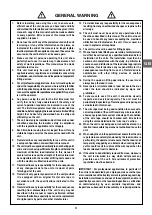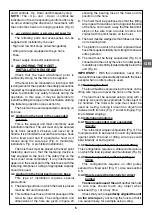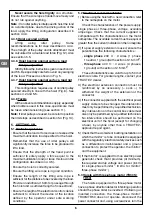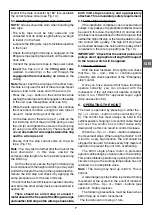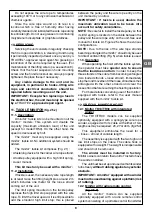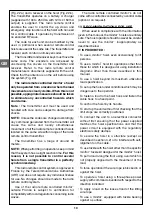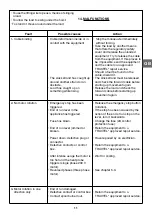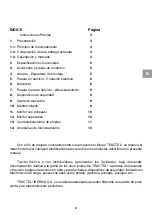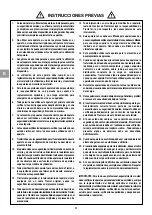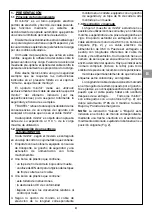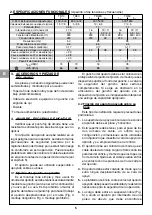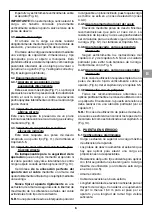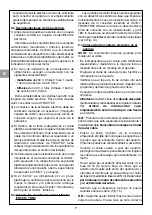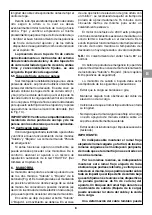
4
1. PRESENTATION
1.1 Theory of operation
The minifor
™
is a portable electric hoist with
feed-through wire rope for lifting and pulling
operations. The hoist implements a self-clamping
drive system providing unlimited lifting wire rope travel.
The drive system is formed by a pulley with
specially-shaped groove in which the wire rope is
clamped under the effect of the load by two swivel
rollers.
A pre-clamping spring which acts on the rollers
maintains the wire rope on the pulley when no load
is attached to the system. Beyond the action of
the pre-clamping spring, the clamping action of the
wire rope on the drive pulley is proportional to the
load.
The technical design of the system ensures a
high degree of safety provided the instructions
given in this manual in the section entitled «
Anchoring the hoist – Installation diagrams » are
strictly observed.
The minifor
™
hoist must only be used with the
specific minifor
™
lifting wire rope with diameter
indicated (see specifications) to fully ensure safe,
efficient use.
TRACTEL
®
declines any responsibility for the
consequences resulting from use of the hoist with
a wire rope other than the minifor
™
wire rope.
Each minifor
™
hoist is tested before shipment for
110 % of its maximum utilization load.
1.2 Composition of a standard supply
MINIFOR
Each minifor
™
(depending on model) is supplied
in a box or metal case containing :
1. The hoist with its control box, equipped with its
carrying handle, its safety hook and a power supply
cable with male/female connector.
2. A plastic bag, containing :
• a low limit stop on spring,
• a 3mm ALLEN wrench to secure the limit stops
on the wire rope
3. A plastic bag, containing :
• this manual
• the CE compliance certificate
• if necessary, the documents concerning the radio
emote control.
4. Depending on the control option, the lifting wire
rope (to the length required) mounted on a reel,
equipped with a safety hook and a high limit stop
mounted on spring.
1.3 Description and markings
Figure 1 shows a standard minifor
™
in its most
frequently used operating position, ready for
operation, suspended on a clamp secured to a
beam. The standard hoist is supplied with a 2.5m
electric control cable with control box (Fig. 2) and
a 0.50 m electrical power supply cable. On request,
the unit can be supplied with different control and
power supply cable lengths. Each unit carries a serial
number on the top of the casing. The complete
number (including letter) must be given whenever
requesting spare parts or repairs.
Regularly check that all the labels are in place
and can be easily read.
The length of the lifting wire rope is marked on
the end sleeve in the hook. If necessary, check
the wire rope length as it is possible that the wire
rope may have been shortened since the unit was
delivered. All the minifor
™
hoists are supplied with
a control box (Fig. 2), with double insulation IP 65
2. FUNCTIONAL SPECIFICATIONS
(On request : other voltages and frequencies)
GB
TR10
TR30
TR30S
TR50
1 ~
1 ~
1 ~
3 ~
1 ~
3 ~
W.L.L. standard/with tackle (kg)
100 / 300
300 / 600
300 / 600
500 / 950
Speed standard/with tackle (m/min)
15 / 7,5
5 / 2,5
13 / 6,5
7 / 3,5
Power (Kw)
0,25
1,1
1,1
Startup current (A)
17,3
16
19 / 11
16
19 / 11
Nominal current (A)
3,9
8
5,9 / 3,4
8
5,9 / 3,4
Power supply voltage (V)
230
230
230 / 400
230
230 / 400
Control voltage (V)
230
230
48
230
48
Frequency (Hz)
50
50
50
Ø of steel wire rope (mm)
6,5
6,5
6,5
Weight of wire rope per meter (kg)
0,17
0,17
0,17
Weight of std hoist (without wire rope) (kg)
21
32
28
32
28
Weight winder with 20 m of wire rope (kg)
+ 23
-
-
-
-
Weight winder with 27 m of wire rope (kg)
+ 28
-
-
-
-
Weight winder with 40 m of wire rope (kg)
+ 30
-
-
-
-
Weight of tackle (kg)
+ 9
+ 10
+ 10
LpA dB(A)
74
73
76
78
LWA dB(A)
86
85
88
90
:



